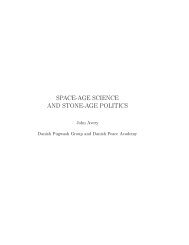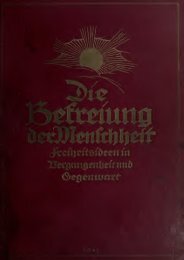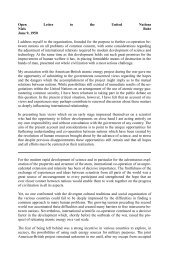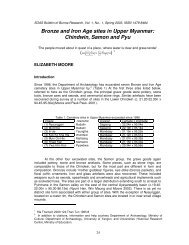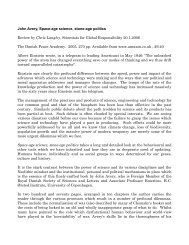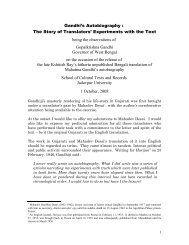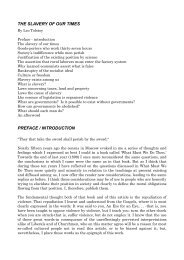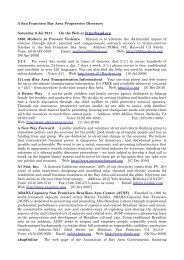History in the new South Africa: an introduction - Det danske ...
History in the new South Africa: an introduction - Det danske ...
History in the new South Africa: an introduction - Det danske ...
Create successful ePaper yourself
Turn your PDF publications into a flip-book with our unique Google optimized e-Paper software.
eliable national data on <strong>the</strong> issue, at least none that are publicly available (it does appear<br />
a considerable amount of data has been collected but not released). McDonald notes that<br />
<strong>the</strong> issue is not simply privatisation per se but publicly-owned <strong>an</strong>d operated service<br />
providers that are commodify<strong>in</strong>g services with negative results for <strong>the</strong> poor. He notes<br />
that cut-offs are now less of a concern “because <strong>the</strong>y became such a political hot potato”<br />
that municipalities feared <strong>the</strong> political backlash of cutt<strong>in</strong>g off basic services, choos<strong>in</strong>g<br />
<strong>in</strong>stead to <strong>in</strong>troduce service ‘restrictions’ (such as small devices to limit <strong>the</strong> rate <strong>an</strong>d<br />
amount of water flow) <strong>an</strong>d <strong>in</strong>troduc<strong>in</strong>g prepaid meters which – <strong>in</strong> his view – have forced<br />
“people to cut <strong>the</strong>mselves off by limit<strong>in</strong>g <strong>the</strong>ir purchases, <strong>the</strong>reby personaliz<strong>in</strong>g <strong>the</strong> cutoff<br />
situation <strong>an</strong>d hid<strong>in</strong>g it beh<strong>in</strong>d closed doors”. 22<br />
The census is not a vehicle for measur<strong>in</strong>g cut-offs, certa<strong>in</strong>ly, <strong>an</strong>d does not help us<br />
engage with <strong>the</strong> debate <strong>in</strong> a specific m<strong>an</strong>ner; but it is not without value. For example, <strong>in</strong><br />
<strong>the</strong> 2001 census, 29.8% of households did not use electricity as <strong>the</strong>ir ma<strong>in</strong> source of<br />
energy for light<strong>in</strong>g purposes – <strong>the</strong> o<strong>the</strong>r 70.2% did use it. The census questionnaire did<br />
explicitly not ask if <strong>the</strong> service was operational, but certa<strong>in</strong>ly implied it by ask<strong>in</strong>g<br />
respondents ‘What type of energy/fuel does this household MAINLY use for cook<strong>in</strong>g,<br />
heat<strong>in</strong>g <strong>an</strong>d for light<strong>in</strong>g?’ (emphasis <strong>in</strong> orig<strong>in</strong>al). The census data <strong>in</strong>dicate that between<br />
1996 <strong>an</strong>d 2001, those without electricity for light<strong>in</strong>g purposes dropped from 4 <strong>in</strong> 10<br />
households (41.8%) to less th<strong>an</strong> 1 <strong>in</strong> 3 (29.8%). It is unlikely that hundreds of thous<strong>an</strong>ds<br />
of people replied ‘electricity’ while me<strong>an</strong><strong>in</strong>g ‘electricity that I would be us<strong>in</strong>g if it hadn’t<br />
been cut off’.<br />
The situation may have worsened s<strong>in</strong>ce 2001, which our data do not show; but between<br />
1996 <strong>an</strong>d 2001 <strong>the</strong> picture is one of exp<strong>an</strong>sion of both connectivity to <strong>the</strong> grid <strong>an</strong>d<br />
utilisation of electricity. The same is true on a smaller scale where water is concerned,<br />
for example. Access to a tap <strong>in</strong> <strong>the</strong> household or <strong>the</strong> yard <strong>in</strong>creased by 1.6% for <strong>the</strong><br />
country as a whole, <strong>an</strong>d by 11.1% <strong>in</strong> ISRDP nodes – but not <strong>in</strong> URP nodes where <strong>the</strong><br />
situation worsened slightly by 0.3%.<br />
While rates of poverty for <strong>the</strong> ISRDP <strong>an</strong>d URP nodes dropped between 1996 <strong>an</strong>d 2001,<br />
this occurred even through nei<strong>the</strong>r ISRDP nor URP were <strong>in</strong> place. (The ISRDP was still<br />
<strong>in</strong> <strong>the</strong> design stage when <strong>the</strong> census was <strong>in</strong> field.) This c<strong>an</strong> largely be expla<strong>in</strong>ed by <strong>the</strong><br />
fact that government’s policy orientation s<strong>in</strong>ce 1994 has been to target <strong>the</strong> ‘poorest of<br />
<strong>the</strong> poor’ particularly <strong>in</strong> rural areas, <strong>an</strong>d m<strong>an</strong>y of government’s target<strong>in</strong>g mech<strong>an</strong>isms<br />
(such as that used for <strong>the</strong> Community Based Public Works Programme) identified <strong>the</strong><br />
same areas for <strong>in</strong>frastructure provision that later became ISRDP/URP nodes, for <strong>the</strong><br />
same reasons – <strong>the</strong>ir high levels of poverty. 23 Moreover, m<strong>an</strong>y redistributive programmes<br />
that beg<strong>an</strong> life under <strong>the</strong> RDP cont<strong>in</strong>ued to be implemented after <strong>the</strong> GEAR strategy had<br />
been adopted by government, <strong>an</strong>d <strong>the</strong>se very poor areas cont<strong>in</strong>ued to benefit from<br />
delivery. The real test for <strong>the</strong> two programmes – <strong>an</strong>d for <strong>an</strong>ti-GEAR critics - will be to<br />
22 Communication from David McDonald 23 rd June 2006.<br />
23 See for example Everatt D. (1998) Target<strong>in</strong>g <strong>in</strong> public works programmes (Department of Public Works<br />
Policy Series, Vol. 1/1); David Everatt, Moagi Ntsime <strong>an</strong>d Lucy Stevens (1998) Monitor<strong>in</strong>g <strong>an</strong>d<br />
Evaluation (Pre-Implementation Task Team of <strong>the</strong> Community Based Public Works Programme); David<br />
Everatt (1998) Target<strong>in</strong>g <strong>an</strong>d budget allocation (Pre-Implementation Task Team of <strong>the</strong> Community Based<br />
Public Works Programme)<br />
37



